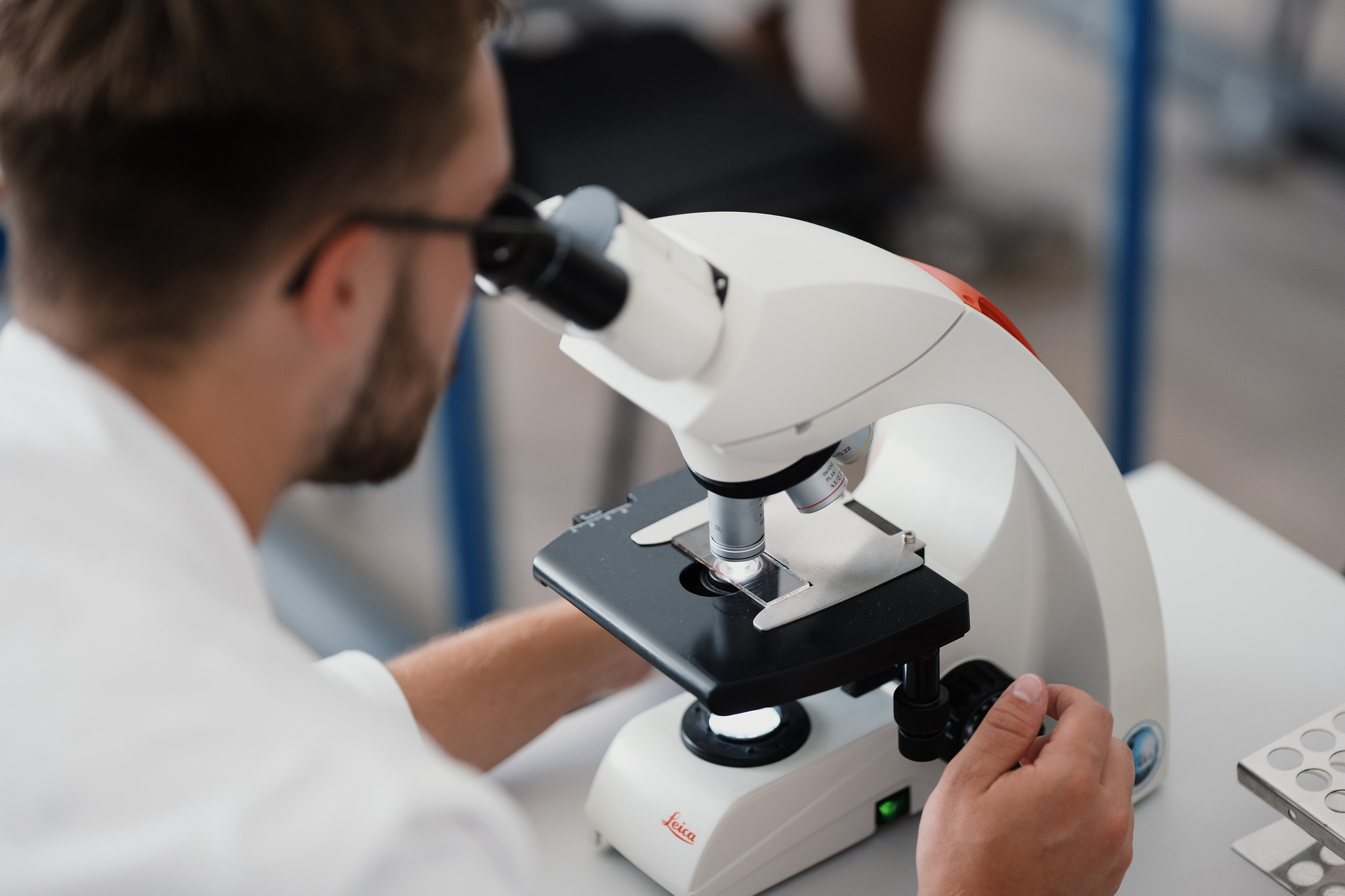Prof. Dalius Jatužis, Dean of the VU Faculty of Medicine: With the Advent of CRISPR Technologies and New Drugs, It Is Likely That Genetic Diseases Considered to Be a “Sentence” for the Patient Will Become Manageable

For the fourth year in a row, the Department of Human and Medical Genetics at the Institute of Biomedical Sciences, part of the Faculty of Medicine at Vilnius University, together with the Lithuanian Society of Human Genetics, is celebrating Medical Genetics Week this month. This year’s Medical Genetics Week is packed full with a variety of events and initiatives, and we invite you to read our interview with Prof. Dalius Jatužis, Dean of the Faculty of Medicine at the University. We talked with the dean about how genetic testing can help to prevent complex diseases in patients, what new technological and scientific breakthroughs we can expect in the future to help treat genetic diseases, the ethical issues that may arise from these new discoveries, and many other interesting things.
How often do you encounter genetic disorders in your practice as a doctor? What are the most common?
Genetics is becoming more and more important in neurological practice every year. It is well known that a significant number of disorders, both at a very early age and later in adulthood, usually have a genetic basis. We may not always know it, and we may not always be able to identify it, but so far, the progress in diagnostics is certainly significant. Today, the most common disorders that we and our genetic colleagues can identify are a very large group of diseases of the locomotor system, various ataxias, early onset Parkinson’s disease, dyskinesias (paroxysmal, etc.), inherited neuromuscular disorders (myopathies, neuropathies, etc.), and some cerebrovascular disorders (such as the autosomal dominant and autosomal recessive cerebral arteriopathies – CADASIL and CARASIL). For example, not long ago, together with our colleagues who specialise in genetics, we described a previously unknown, newly identified case of autosomal recessively inherited arteriopathy – the CARASIL variant. There are also diseases of the blood coagulation system, dementia (inherited variants of early onset Alzheimer’s disease, or frontotemporal dementia), and Huntington’s disease (manifested by both movement and cognitive impairment). The latter is a severe autosomal dominantly inherited disease with a specific gene that geneticists have long been able to identify, and this test is essential to confirm the diagnosis. There are more than 200 diagnosed cases of this disease in Lithuania.
How are genetic knowledge and recent discoveries changing the diagnosis and treatment of neurological diseases?
In some cases, fundamentally. One of the best examples is the universal screening of newborns for a range of diseases, including spinal muscular atrophy. This is an inherited disease that manifests itself in muscle atrophy and weakness at a very early age. Neonatal screening enables the early detection of this disease so that it can be treated effectively. Around the world and in Lithuania, we already have drugs which, if administered to babies early on, can prevent this rapidly progressive and fatal disease. With early diagnosis, screening and appropriate drugs, babies who would have been doomed to slow development and early death just 10 to 15 years ago can now reach adulthood and live full lives. This is truly a huge advance. The same is true for other diseases: either treatments have already been approved or are in late-stage trials, expected to enter clinical practice soon. Hereditary Friedreich’s ataxia and some sphingolipidoses are also worth mentioning. Recently, the US Food and Drug Administration (FDA) approved a drug for the treatment of a dramatic, very serious neurological disease, the SOD1 mutant variant of amyotrophic lateral sclerosis, based on genetic discoveries. The drug acts on the mRNA produced by the mutant SOD1 genes and effectively reduces the synthesis of toxic SOD1 proteins. So, we can see that both diagnostic discoveries and drugs that are developed based on an already known genetic change, which has a profound effect on the prognosis and course of the disease itself and reduces the risk of disability, are vitally important.

Prof. Dalius Jatužis
Could you share a specific example where genetic testing has fundamentally changed a patient’s treatment plan?
The most memorable clinical cases are probably the ones where, once the genetic cause has been identified, we are able to offer a very specific treatment to the patient. One of the most memorable cases was ten years ago. A young man, who had already seen more than one doctor, presented with rather unusual symptoms – a high fever and sudden episodes of acute pain, with severe dizziness, impaired eye movement (nystagmus – when the eyeballs “twitch”) and strabismus (vision disorder in which the eyes do not properly align with each other when looking at an object). All these symptoms manifested themselves in attacks that could last for several days. By the time the next episode occurred, they would feel relatively well. Attacks would recur every few weeks. The combination of symptoms is indeed quite unusual, and it would have been difficult to find what it might indicate in classical neurological textbooks. It was only when we found out that the patient’s brother had similar symptoms that we turned to geneticists for advice. Together, based on genetic tests, it was discovered that the patient, as well as his brother and possibly other family members, had a rare excess of immunoglobulin D. This is the syndrome that later turned out to be the cause of the seizures. We referred the patient to the rheumatologists, and with the appropriate treatment (the patient was prescribed an effective biologic that specifically addresses the pathophysiological mechanisms of the disease), they went on to live a full life. The episodes either virtually disappeared or became much milder. The patient’s quality of life and ability to carry on with normal activities was changed dramatically.
Are there any new technologies or research in medical genetics that are particularly relevant to the future of neurology?
There are a lot of discoveries, and it is getting hard to keep up with all the news. Whereas neurological testing used to be the basis for diagnosing diseases of the nervous system, the “questionnaire-examination, followed by tests like the hammer-knee reflex”, so to speak, modern neurology today is hard to imagine without the contribution of genetic testing. If a few decades ago, the discovery and introduction into clinical practice of imaging tests (computed tomography, magnetic resonance imaging), which make it possible to see the structures of the brain, was a major breakthrough, today we are probably experiencing a second similar breakthrough, with genetic testing opening up a whole new range of possibilities for detecting previously unknown diseases and their causes. It has become standard in our clinical work to genetically test all patients with Parkinson’s symptoms before the age of 40, all strokes occurring in patients before the age of 50, and dementias and milder cognitive impairments at a younger age. Such diagnostic technologies and advances are essential for us to better identify the cause of the disease. The other important part is treatment: we have high hopes for CRISPR and similar technologies that allow us to modify the genome by replacing defective fragments with the right nucleotide sequences. This is not yet our daily reality, and we look forward to it in the future, and probably not so far in the future. As early as this year, the US FDA is expected to approve some drugs or technologies related to the correction of defective genome fragments. This is a significant development in the treatment of previously incurable diseases of the nervous system and the whole body. We are also looking forward to new drugs that target genetically determined defective processes with high precision. Some diseases already have a cure, but there are still a great many that, despite being diagnosed nowadays by genetic testing methods, still do not have an effective cure. There is no doubt that they will emerge, and the process has already begun. It is likely that a snowball effect will trigger the emergence of new drugs to target nucleotides, DNA, RNA sequences or other genetic defects and allow us to manage even those diseases which, until very recently, were regarded as an unendurable sentence for the patient and their family members.
To go beyond the collaboration between neurologists and geneticists, we should also mention personalised medicine, which is about making both medical and non-medical treatments as precise as possible, or else focusing on the individual patient rather than on a statistical average of a large sample of people. Today, this is standard practice: large numbers of patients – thousands, sometimes tens of thousands – are sampled in the development of new medicines and in testing their efficacy and safety. The success of a trial is assessed on the fact that, for a large group of patients, a particular medicine was sufficiently effective and tolerably safe. However, in that large sample of people, that large average, we are ‘losing’ individual patient profiles. In our clinical practice, we are confronted every day with the reality that the same medicine can work well for one person, but badly for another, even though they both have the same disease. This is undoubtedly because everyone’s genetic makeup is different. Our genes programme our response to a drug in one way or another. For this reason, a person with one set of genes responds well to a medicine, and it helps and is safe, while a person with different genes either does not respond to the same medicine at all or the medicine simply does not help them. Personalised, individualised or precision medicine (the name is still being debated), seeks to identify the genes, or sets of genes, in each individual case that determine the response to the drug so that instead of treatments being prescribed “roughly” (the principle of averaging over a group of people), this would be done with the maximum possible precision for each individual. In this way, a more specific, precise selection of a drug or a technological treatment approach, such as stimulation or surgical interventions, can be considered in combination with the genetic profile of the person. When we can identify the human genes, or the fragments of genes, that will determine how the human body will respond to the intended treatment, then it will be possible to start immediately with the most effective treatment. This saves money and resources and prevents us from prescribing drugs that are not really going to work for that patient or that they will not tolerate.

Prof. Dalius Jatužis
What challenges do you face in integrating genetic science into clinical practice, and how do you address them?
Advances in knowledge and practice and the fact that we can increasingly identify the specific genetic cause of a disease are very important. However, we have a major challenge: diagnosis is still outstripping treatment options. There are still many diseases that we can diagnose perfectly well, even with very specific identification of the genetic “target”, but we simply do not yet have effective molecular drugs. The process is ongoing, but we are not there yet. So, when we communicate with patients and their relatives, we have a certain challenge: we can tell them the diagnosis, but we cannot necessarily offer a cure. The natural question for the patient is: What will happen now, and what will my treatment be? And sometimes, we don’t have a cure yet. We have an ethical problem: how to work with the patient and their relatives, what to offer (supportive measures, better adaptation to society, etc.) in the absence of a treatment or something that fundamentally changes the course of their disease.
The other problem is that we, as doctors, must frequently change our work structure, habits and principles frequently. Many, if not all, genetic diseases do not just affect one organ system or one tissue type but affect many systems. For example, it is not just a neurological symptom or syndrome, but there are also problems with vision, the heart, the skin, the endocrine glands, other internal organs, and so on. When dealing with a patient with a genetic problem, we need to rely on the principle of multidisciplinary working, where the same patient is followed up by several different specialists from various areas of expertise who provide advice and prescribe treatments. This multidisciplinary team consists not only of a neurologist and a geneticist but often also of a rheumatologist, a cardiologist, an ophthalmologist, and other specialists as needed.
Multidisciplinary work requires additional organisational resources when it comes to organising a consortium or moving towards case management. The patient case manager organises and coordinates the help of different specialists, prescribes new medicine if necessary, and deals with various other problems that arise daily. Gone are the days of going to one doctor, who, after commenting on something in their area of expertise, refers the patient to another specialist, who then re-examines the problem, perhaps repeating the same tests unnecessarily without knowing what has already been done or prescribed by the previous specialist. There is a need for a certain amount of reorganisation of medical care and how the service functions, which is still a challenge in our medical system, both in terms of resources and working traditions.
One of the challenges ahead is that when CRISPR or other so-called gene “scissor” technologies are introduced into medicine, ethical issues are likely to arise: is a person with a modified genome still the same person? Even if the purpose of the modification was purely medical or therapeutic. Where are the limits to the extent to which we, as medics and scientists, can interfere in the modification of human DNA and the whole genome? We are already familiar with this dilemma from the possibilities of artificial insemination. Similar problems may come into view when treating genetic diseases.
If you could have a “superpower” that genetic mutation would bring about, just for fun or convenience in everyday life, what would it be and why?
It’s difficult to say, but I probably wouldn’t want to have a mutation in me. But for fun, it might be quite interesting to be able to see letters and numbers in colours. Or, for example, to see the colour of the wind. In other words, to see words, music, etc. enriched with colours, smells or other sensations. This is not, of course, the stuff of fiction. This phenomenon is called synaesthesia, and it is a phenomenon shared by a not-so-small minority of people who, when they feel one kind of stimulus, are also able to feel another kind of stimulus at the same time. For such people, each letter or number has its own distinct colour, the sound of music has its own smell or colour, and so on – there are multiple options. New sensations and better memorisation – it would really be interesting to try this out.